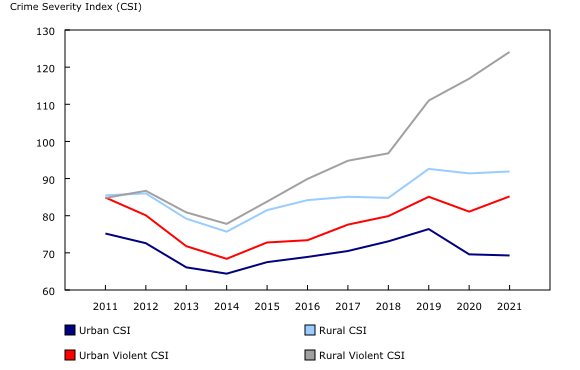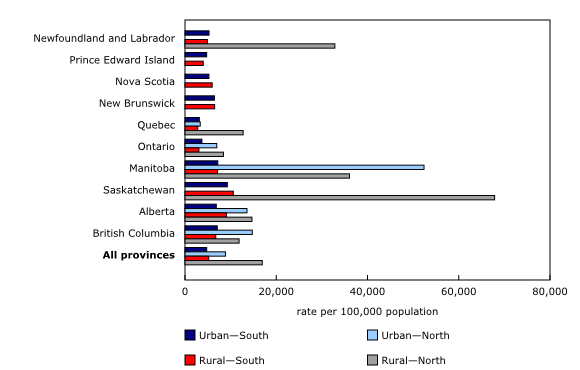Police-reported crime in rural and urban areas in the Canadian provinces, 2021
Released: 2023-02-20
In 2021, police services serving a mostly rural population represented 15% of the population of the provinces, but reported 24% of violent crimes, 18% of property crimes, 30% of Criminal Code traffic offences and 23% of other Criminal Code violations recorded in the provinces. The gap widened during the COVID-19 pandemic, which saw a decrease in the urban crime rate, but not in the rural rate.
A comparative analysis of crime reported by police services that serve rural and urban areas is presented in the Juristat article "Police-reported crime in rural and urban areas in the Canadian provinces, 2021" released today. The study found that the rural crime rate was higher than the urban crime rate, mostly because of higher rates in the rural areas of the Prairies and the northern regions of provinces.
The Crime Severity Index is higher in rural areas than in urban areas
The Crime Severity Index (CSI), which measures both the volume and the severity of crimes, was 33% higher in rural areas (91.9) than in urban areas (69.3). The difference was even greater for the Violent CSI, which measured 124.1 in rural areas and 85.2 in urban areas in 2021. The gap in the Violent CSI has grown over the past decade. In 2011, the rural Violent CSI (84.8) and the urban Violent CSI (84.9) were virtually the same.
Some high-volume offences accounted for much of these differences. For example, the rates for assault, violent firearms offences, mischief, disturbing the peace and impaired driving were much higher in rural areas than in urban areas. The rate of intimate partner violence was also nearly double in rural areas, with the difference between the two areas growing since 2018.
Rural residents were more likely than urban residents to live in a place with a relatively low crime rate: 34% lived in a community where the crime rate was less than 3,000 incidents per 100,000 population, compared with 25% of urban residents. Therefore, the relatively high crime rate in rural areas was primarily attributable to a few communities with a very high crime rate. In fact, 14% of rural residents lived in a community where the crime rate was 10,000 or more incidents per 100,000 population (compared with 6% of urban residents).
In 2021, crime rates were particularly high in the northern regions of the provinces and in the Prairies.
Note to readers
This analysis is based on police-reported data from the Uniform Crime Reporting Survey. A number of factors can influence police-reported statistics. For example, an incident must come to the attention of the police. Differences between police services, such as in available resources or departmental priorities, policies and procedures, can also have an effect on police-reported crime. For instance, some police services may use municipal by-laws to deal with minor offences. The territories are excluded from this analysis on rural crime since they differ from the provinces and among each other in many respects.
Urban areas are those where the majority of the population lives within a census metropolitan area (CMA) or census agglomeration (CA). Rural areas are those where the majority of the population lives outside a CMA or CA. A CMA or CA is formed by one or more adjacent municipalities centred on a population centre (known as the core). A CMA must have a total population of at least 100,000, of which 50,000 or more live in the core. A CA must have a core population of at least 10,000. To be included in a CMA or CA, adjacent municipalities must have a high degree of integration with the core, as measured by daily commuting flows derived from census data. A CMA or CA may have more than one police service.
The Provincial North comprises the northern regions of British Columbia, Alberta, Saskatchewan, Manitoba, Ontario, Quebec, and Newfoundland and Labrador. For more information, consult the Variant of Standard Geographical Classification (SGC) 2021 for North and South on the Statistics Canada website.
The crime rate and the Crime Severity Index (CSI) are complementary measures of police-reported crime. The crime rate measures the volume of crime reported to the police per 100,000 population, while the CSI measures both the volume and severity of crime reported to the police.
Products
The article "Police-reported crime in rural and urban areas in the Canadian provinces, 2021" is now available as part of the publication Juristat (85-002-X). The infographic "Police-reported crime in rural and urban areas, 2021" (11-627-M) was also released today.
Contact information
For more information, or to enquire about the concepts, methods or data quality of this release, contact us (toll-free 1-800-263-1136; 514-283-8300; infostats@statcan.gc.ca) or Media Relations (statcan.mediahotline-ligneinfomedias.statcan@statcan.gc.ca).
- Date modified:


